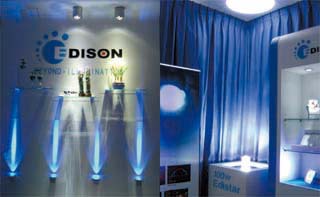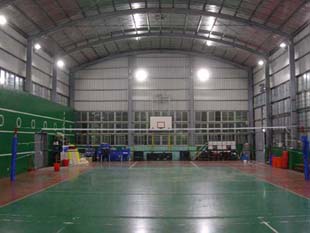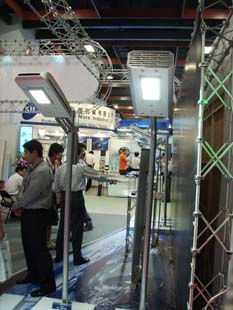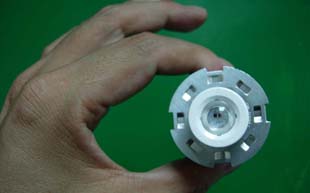Tapping Advanced Cooling Technologies to Make LEDs More Popular
2008/04/07 | By Ken LiuWith continued and frequent industry reports of the bright prospects for LED lighting to take over increasingly bigger roles in all manners of illumination in various settings, including home, office, institution and public places, more and more LED-packaging startups in Taiwan have braved the still relatively new waters of the LED lighting sector over the past few years. Perceiving the increasing feasibility of adopting LEDs in various broad-area and pinpoint illumination, these newcomers are competing to design and build workable lamps based on their proprietary technologies.
Technologically, these LED-packaging newcomers are backed by solid engineering professionals with considerable expertise in either thermal-dissipation or packaging. As such, many of these packagers have already set light waves rolling through the sector by launching high-powered lamps boasting thousands of lumens in brightness. Besides succeeding technologically, they have managed to have their products installed at many locations worldwide, whether indoors or outdoors.
One such pioneering specialist is Edison Opto Corp., founded in October 2001 by SMD-LED packager Harvatek Inc. and several seasoned LED technologists in Taiwan, who aim to make high-powered LED modules for lighting fixtures. In fact, the company claims to be a global leader in supplying high-powered LED lamps.
Adopting high-powered chips from Cree Inc., Edison has so far introduced several high-intensity lamps, including 1W-5W Edixeon lineup for various lighting purposes; 5W-20W EdiPower lineup for indoor lighting purpose; 5W-100W EdiStar lineup for outdoor purposes like street-lighting and tunnel lights; and 3W-5W EdiLine for decorative lighting purposes.
Edison's 10W PAR30 module features six Edixeon LED lamps, enabling it to give off up to 3,700 lux in illumination from as far as one meter from any surface. (One lux is the brightness of a candle from about 30cm. away.) This module integrates the company's advanced LED technology with proprietary optics design and heat sink.
Its 50W EdiStar module, measuring 50mm x 50mm x 2mm, incorporates the company's most advanced packaging and material technologies, enabling it to emit 3,000 lumens of brightness, whereby its application range is considerable.
Seen to be engaged in outstanding work to improve module-packaging processes, the company won sponsorship from the Taiwan authorities in 2005 to continue its 100W-LED packaging program, enabling the firm to unveil its 100W, 6,400 lumen EdiStar lamp in the following year.
Overall Winning Strategy
Edison president Jason Wu says that as increasingly more traditional light sources are replaced by high-powered LEDs, the LED-lighting sector has seen more and more newcomers. "In the face of growing and acute competition, Edison has been able to realize an overall winning strategy-offering a total solution that overcomes thermal, electrical, mechanical and optical hurdles as well as efficient manufacturing and marketing services," he says.

Wu believes that consumers globally will increasingly embrace LED lamps for their energy-efficiency in light of the growing sensitivity for the need of green products as the world comes to grips with the impending urgency of global warming, as well as officially-backed programs worldwide to promote ecological lighting. He notes that, in addition to consistent efforts on packaging-technology development, his company is also working hard on technologies to improve lighting characteristics, including chromaticity, color-rendering and color-temperature.
After generating 60% more revenues last year, Edison projects revenues to grow further in 2008 due largely to the widening trend to replace power-guzzling, environmentally-harmful lamps with LED-equipped counterparts.
Edison ships most of its products to Europe and the U.S. with a variety of green approvals, including RoHS.
In October 2006, the company opened a factory in Dongguan of Guangdong Province, China, whereby the firm is able to, backed by efficient production equipment, provide complete product support and on-time delivery.
Heat-dissipation Specialist
Known now in the sector as a specialist who has been able to effectively overcome heat build-up in LEDs, a key drawback of light-emitting-diodes, Thermoking Technology International Corp. has also offered thermal solutions for a variety of electronic devices. Thermoking began applying its thermal expertise to LED lamps in late 2005 as it saw bright market prospects in the sector.

The company has already introduced technologies to make LED lamps in power specifications ranging from 100 to 1,000 watts, as well as having launched 150-350 watt LED streetlights. Making such products reality calls for designing thermal-dissipation technologies superior to ones already on the market, and the brains behind the innovation is Thermoking vice-chairman Hsin-ning Guan, who says that his unique technology limits temperature increase to just 0.09 degree Celsius for each added watt, and to a maximum of only 22 degrees whatever the wattage.
Backed by such incredible heat-dissipation know-how, the company is poised to design and build even larger LED lamps.
Guan dubs this new technology "thermal-dispersion superconductivity," which is better than the heat-dissipation technologies used with 70 to 150 watt computer microprocessors. This is particularly important to high-wattage LED lamps, he explains, because those lamps have at least seven interfaces, from LED dies to fans, which are heat sources.
PCT Patented
Guan says that his thermal-dissipation technology is patented under the Patent Corporation Treaty (PCT), which is recognized by 135 member states.
Adopting the highly-effective thermal-dissipation solution, Guan boasts, ensures the company's lights to suffer only a 5-8% drop in rated light output after 12,000 hours of non-stop operation. Thermoking's specially-designed thermal fan, Guan reports, works for a guaranteed 50,000 hours thanks to its IP65-grade dustproof and waterproof design. "Compared with a 400-watt HID lamp, our 150-watt lamp saves up to 60% of electricity," he claims.
The vice chairman goes on to say that his technology employs not only artificial ventilation via fanning but also a bottom-side grille to allow heat to escape. "Most of the rival technologies stress ventilation based on thermodynamics, installing topside grilles for hot air rises. But such openings tend to foul, especially in outdoor applications, after extended service because of clogging due to debris and bird droppings."
Despite its relatively complicated design, the company's thermal-dissipation module measures just 120mm x 140mm x 66mm and weighs only 850 grams. Such compactness has been achieved via Thermoking's outstanding system-integration capabilities, Guan says, adding that counterparts based on thermodynamic principles can be 15 times as large, but still showing "relatively poor performance in dissipating heat."
The company's 350-watt street lamp has 192 one-watt LED chips and remains as bright as new even after 5,000 hours of continuous operation. "Theoretically our lamps can last as long as five years," Guan comments, "but we sell them with only a two-year warranty."
Both highly efficient, the firm's 150-watt lamp emits 5,000 lumens and its 350-watt lamp 12,000 lumens, with the former delivering 55 luxes of brightness to the ground from a height of 10 meters. "This is much better than the standard set by the Chinese National Standard (CNS), which requires 10.7 to 21.4 luxes, and it saves 60% in electricity compared with a 400-watt HID (high-intensity discharge) lamp," Guan insists.
So far, Thermoking's lamps have been installed at a Kaohsiung campus run by the Buddhist Tzu Chi Foundation and in the gymnasium of an elementary school near the company, which is headquartered in Wugu, Taipei County. Plus the company's streetlamps have passed field tests run by Xiamen City government in mainland China; while Guan says that his company has landed orders from Europe, the United States, Japan and China.
"To target a new segment," Guan says, "we will be focusing on selling intellectual property. So we'll concentrate on public-works projects first, followed by factories and households." Prices will drop enough to be attractive to residential users, the vice chairman believes, only when the first two segments will have grown significantly to achieve economy of scale. He once predicted that this would take five years for each market segment, but a flood of inquiries has driven him to be more optimistic-shortening such projection to just two years per segment.
Loop-heat Pipe Technology
Advanced Thermal Devices (ATD) Inc. was founded in 2005 to develop heat-handling technologies and has since built a patented thermal-dissipation module called "loop heat pipe (LHP), which has been installed in 18W, 25W, 100W and 150W LED streetlights.
The company's chief technology officer Dr. Fu-sheng Sun says that the thermal technology was originated by the Soviet Union in 1982 for use in spacecrafts. His company worked with the National Taiwan University and Russian Science Academy to adapt the aerospace thermal technology to be applicable to LED streetlights, with such improvements having been patented for thermal solutions in LED streetlights.

The LHP is quite structurally simple, comprising of a notebook-sized aluminum plate with a closed-pipe-loop atop. Water inside the pipe acts as coolant and is pumped through the pipe by an "evaporator," which vaporizes the water as it picks up heat. The vapor then releases heat as it cools to ambient levels, and is condensed into water by the condenser. The water reflows through the evaporator via a connecting pipe, with the water carrying away heat, or cooling, in each loop.
This closed-loop thermal-dissipation technology, according to Sun, can maintain maximum junction temperature of lamps at 60 degrees Celsius. Thanks to the excellent cooling effect, the company's 150-watt lamp can emit 8,836 lumens, with each watt producing 63 lumens. Weighing 8.5 kilograms, the lamp saves over 50% in electricity relative to a mercury lamp.
On a 15-meter-wide roadway, one of ATD's lamps at 12-meters high delivers 14.6 luxes per square meter, translating into one lumen at an angle of 30 degrees and 35 meters away.
The company has successfully built the thermal module into LED streetlights giving off 60 lumens per watt.
Fan-free Compactness
"Our thermal module works without cooling fans, making it light and compact," Sun says, and the module weighs less than three kilograms.
Sun notes that the former Soviet Union developed the LHP as a thermal-dissipation device for space flights because the design works even in zero gravity and its heat- conduction distance is theoretically long.
LED streetlights equipped with ATD's LHP module are now lighting up the National Taiwan University campus and Southern Taiwan Science Park. "We will apply the technology to other applications like personal computers," Sun concludes.
The module, however, is hobbled by one drawback currently: its US$100 price tag makes it cost-ineffective for some applications. "There is ample room for our cost to come down. When that happens, we believe our module will be more widely practical," Sun says.
Heat-piped NeoBulb
NeoPac Lighting Inc. was established in 2005 as an LED packager. The company has introduced a proprietary LED lamp called "NeoBulb," which was developed around an efficient thermal-dissipation technology dubbed "heat pipe."
According to the company's chairman and chief executive officer, Jeffery Chen, the dissipation technology can effectively keep the junction temperature of the positive and negative electrodes of LED chips within a narrow range. For instance, the technology chills the company's 135W streetlight, which is equipped with 18 NeoBulbs, to under 60 degrees Celsius at its junction, enabling it to emit 5,000 lumens. "Our light achieves the best performance in terms of general illumination," Chen claims.
"Heat is the major killer of LED illumination," Chen explains. "The higher the heat, the faster the brightness decays."
Chen says he plans to boost the efficiency of his company's 135W streetlight to 75 lumens-per-watt soon, up from 37 lumens, to achieve a total intensity of 10,000 lumens. "By doing that," Chen stresses, "we will break the Haitz Law and boost total lumens without any restriction."
Haitz Law, named after its creator Roland Haitz and retired scientist from Agilent Technology, says that, as predicted in 2003 and based on the previous record, for each doubling of illumination every 18 to 24 months, the lumens of a single LED would increase 20 fold while the price of the diode would fall to one-tenth of the 2003 level by 2013. "Our achievement has Mr. Haitz doing double-takes," Chen reports, showing an e-mail from the scientist on his computer screen.
The heat pipe is a commonplace technology used in the PC industry to dissipate heat from PCs. However, Chen stresses: "We're the first LED packager to apply the technology to LED lamps and to have succeeded in reducing the junction temperature."
NeoPac's heat pipe is an aluminum tube with stacked aluminum heat-dissipation fins. Measuring 50mm to 120mm in length, the pipe suits various kinds of lighting fixtures. The company mounts its patented NeoPac Emitter LED module onto a pipe with its own "system-in-a-package" technology to render the patented "light engine." The housing-encased engine hence becomes a "NeoBulb" lamp which, the company says, is a versatile lighting platform.

Numerous Patents
Backed by at least 50 patents for its LED lighting technology, NeoPac recently introduced the 75W, 2,500-lumen "Lotus Lantern" aimed at the huge mainland Chinese market, a product with enormous potential with the upcoming 2008 Olympic Games in Beijing as well as for its energy-efficiency.
Leveraging the huge business potential generated by the Chinese LED market that is backed by its technological expertise, NeoPac recently won a contract to supply LED streetlights to an Olympics park in Beijing, along with similar contracts in Shenyang, Tianjin, and Shenzhen.
Lighting in the most populous nation consumes about 12% of China's electricity, but Chen estimates that such percentage could be cut in half by replacing general-purpose light bulbs with LEDs: so much in fact that the saving would equal twice the power to be generated by the Three Gorges hydroelectric facility.
China's "Eleventh Five-Year Plan Guideline" or the official infrastructural building program covers 2006 through 2010, calling for LEDs to be used first to replace fluorescent lamps in Shanghai residences, and then for LED-lit industrial bases to be built up in Dalian, Nanchang, Xiamen, and Shenzhen, in addition to Shanghai. The LED-lighting sector is expected to generate revenues of about RMB150 billion (US$20.2 billion at RMB7.4: US$1), according to a report released in Shanghai during the 4th China International Exhibition and Forum on Solid State Lighting in August 2007.

